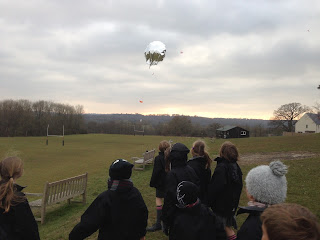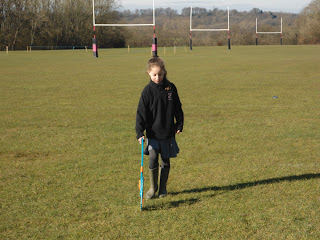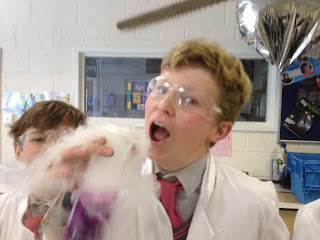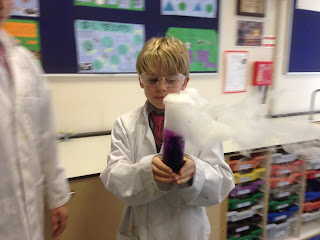Yesterday we had another pair of balloons launched from Brambletye. The GPS system sent us some interesting but possibly unreliable data. The balloon either went up to 11.5km high or 7.5km high and stopped sending data when it was out at sea south of Newhaven. It may even have floated as far as France! More tests required. Here is the launch:
IMG_3178 from Brambletye on Vimeo.
IRP
Wednesday, 23 March 2016
CE revision course at Easter
Having reviewed the exam results this term we feel that the current Year 8 pupils have made particularly good progress with the Chemistry syllabus. It is therefore a good idea that the science revision course on 14th and 15th April should be more general rather than focus solely on Chemistry. As a relatively small number have signed up so far we will be able to tailor the course to the needs of those who attend.
IRP & MH.
IRP & MH.
Thursday, 17 March 2016
Brambletye Space Program Test 1
Yesterday our budding astronauts and cosmonauts set off a couple of helium balloons as test flights for our Brambletye Space Program.
First the balloon needs to be partially filled with helium.
The balloon will get bigger as it gains altitude because atmospheric pressure decreases with altitude.
Then the tracking equipment and a small parachute need to be attached.
The parachute will control the descent rate to about 5m/s.
The tracking equipment needs to be ready and receiving signals from the balloon.
We needed to launch from a site well away from trees
The balloon is ready
10, 9, 8, 7, 6, 5, 4, 3, 2, 1.
And off it goes
Up, up and away
The trackers give us vital information:
First line is all about signal strength and frequency
Second line shows the time and the N coordinates
Third line shows battery life and the W coordinates
fourth line shows speed in knots, Altitude in m and temperature in degrees C
We used the coordinates in google maps to track where the balloon was.
This is near its last message.
We had two receivers for each balloon just in case one failed. The picture shows the last message each received. The balloons were still going the highest one was at 8.5km altitude, doing 66 knots (that's about 120kph) and the temperature was -54 degrees C. In all likelihood the batteries failed at this very cold temperature. It was 175km away from school and still going strong!I would like to say a very big thank you to the enthusiastic Dads who have helped with their expertise and equipment. Without them this project would not have been inspired yet alone realised.
Saturday, 12 March 2016
It is Rocket Science
Yesterday Y7 used their knowledge of pressure
to launch rockets.
First you need to add some water.
This will be the propellant
Different amounts were used each time by some groups
Measured carefully of course
So that it was an accurate investigation
The rocket was attached to a pump
and pumped to increase the pressure inside the bottle
It builds up and up.
The excitement builds
And the rockets fired
pushing the water out backwards
so they shoot forwards (Newton's third law of motion)
"Every action has an equal and opposite reaction"
Lots of groups all working harmoniously
Some groups tried different amounts of water each time
Some tried different angles of the gutter launch system
They all shot across the terrace
and the length od flight was measured
And then written down.
Friday, 4 March 2016
Year 6 determine the speed of sound by experiment
It was a lovely sunny day on which to do a very large experiment. Finding the speed of sound.
We needed a large distance so we went to the Nevill field
Speed = Distance / Time so we need to measure the distance.
This was done with a trundle wheel
and a lot of counting!
We checked it a few times
to make sure the result was reliable
as there are a lot of clicks to count
and the listeners kept moving (but not much).
We put our sound source at the other end of the long distance
The clapper board was used to make a loud bang
We can see the boards crashing together and that's when we started the timers
Then we stopped the timers when we heard the sound a fraction of a second later
and wrote the times down
We did this many times so we could try to rule out any errors
We changed jobs too so everyone got to experience seeing the clapper crash shut before hearing the bang a moment later.
This is why you see the runners start a moment before you hear the starting pistol when you are by the finish line on Sports Day. Also why the bat seems to hit the ball before you hear it when you are watching cricket on the boundary. Fireworks do the same, flash of light before you hear the big bang and its why if you look at where the sound is coming from you wont see the aircraft that's making it. The plane will be further ahead well in front of its sound.
We have all of the data now so next lesson we will have to do some calculations and see if we have an accurate result.
Thursday, 3 March 2016
7C have fun with Dry Ice
7C had a little experiment with dry ice in the lab today.
This is solid carbon dioxide, at -78 degrees C
which will sublime into gaseous carbon dioxide
without going through the liquid phase
so when you put it in hot water
it sublimes really quickly.
Hence it gives off very cool carbon dioxide gas
but this is NOT the smoke you see
That is a cloud!
That's right we made clouds in the lab
The cold carbon dioxide reduces the temperature of the air above the water
which means it can't hold so much water vapour
so it condenses forming microscopic water droplets
OR clouds!
Look at the previous blog entry to see the dry ice Hero Engine.
Subscribe to:
Comments (Atom)


























































